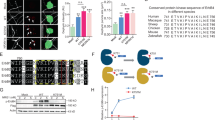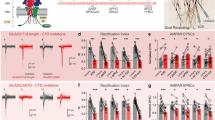Abstract
Neuroligins are postsynaptic cell adhesion molecules that are important for synaptic function through their trans-synaptic interaction with neurexins (NRXNs). The localization and synaptic effects of neuroligin-1 (NL-1, also called NLGN1) are specific to excitatory synapses with the capacity to enhance excitatory synapses dependent on synaptic activity or Ca2+/calmodulin kinase II (CaMKII). Here we report that CaMKII robustly phosphorylates the intracellular domain of NL-1. We show that T739 is the dominant CaMKII site on NL-1 and is phosphorylated in response to synaptic activity in cultured rodent neurons and sensory experience in vivo. Furthermore, a phosphodeficient mutant (NL-1 T739A) reduces the basal and activity-driven surface expression of NL-1, leading to a reduction in neuroligin-mediated excitatory synaptic potentiation. To the best of our knowledge, our results are the first to demonstrate a direct functional interaction between CaMKII and NL-1, two primary components of excitatory synapses.
This is a preview of subscription content, access via your institution
Access options
Subscribe to this journal
Receive 12 print issues and online access
$209.00 per year
only $17.42 per issue
Buy this article
- Purchase on Springer Link
- Instant access to full article PDF
Prices may be subject to local taxes which are calculated during checkout







Similar content being viewed by others
References
Yamagata, M., Sanes, J.R. & Weiner, J.A. Synaptic adhesion molecules. Curr. Opin. Cell Biol. 15, 621–632 (2003).
Dean, C. & Dresbach, T. Neuroligins and neurexins: linking cell adhesion, synapse formation and cognitive function. Trends Neurosci. 29, 21–29 (2006).
Dalva, M.B., McClelland, A.C. & Kayser, M.S. Cell adhesion molecules: signalling functions at the synapse. Nat. Rev. Neurosci. 8, 206–220 (2007).
Craig, A.M. & Kang, Y. Neurexin-neuroligin signaling in synapse development. Curr. Opin. Neurobiol. 17, 43–52 (2007).
Südhof, T.C. Neuroligins and neurexins link synaptic function to cognitive disease. Nature 455, 903–911 (2008).
Chih, B., Engelman, H. & Scheiffele, P. Control of excitatory and inhibitory synapse formation by neuroligins. Science 307, 1324–1328 (2005).
Dean, C. et al. Neurexin mediates the assembly of presynaptic terminals. Nat. Neurosci. 6, 708–716 (2003).
Graf, E.R., Zhang, X., Jin, S.X., Linhoff, M.W. & Craig, A.M. Neurexins induce differentiation of GABA and glutamate postsynaptic specializations via neuroligins. Cell 119, 1013–1026 (2004).
Levinson, J.N. et al. Neuroligins mediate excitatory and inhibitory synapse formation: involvement of PSD-95 and neurexin-1β in neuroligin-induced synaptic specificity. J. Biol. Chem. 280, 17312–17319 (2005).
Nam, C.I. & Chen, L. Postsynaptic assembly induced by neurexin-neuroligin interaction and neurotransmitter. Proc. Natl. Acad. Sci. USA 102, 6137–6142 (2005).
Wittenmayer, N. et al. Postsynaptic Neuroligin1 regulates presynaptic maturation. Proc. Natl. Acad. Sci. USA 106, 13564–13569 (2009).
Ichtchenko, K. et al. Neuroligin 1: a splice site-specific ligand for β-neurexins. Cell 81, 435–443 (1995).
Irie, M. et al. Binding of neuroligins to PSD-95. Science 277, 1511–1515 (1997).
Iida, J., Hirabayashi, S., Sato, Y. & Hata, Y. Synaptic scaffolding molecule is involved in the synaptic clustering of neuroligin. Mol. Cell. Neurosci. 27, 497–508 (2004).
Poulopoulos, A. et al. Neuroligin 2 drives postsynaptic assembly at perisomatic inhibitory synapses through gephyrin and collybistin. Neuron 63, 628–642 (2009).
Ichtchenko, K., Nguyen, T. & Südhof, T.C. Structures, alternative splicing, and neurexin binding of multiple neuroligins. J. Biol. Chem. 271, 2676–2682 (1996).
Song, J.Y., Ichtchenko, K., Südhof, T.C. & Brose, N. Neuroligin 1 is a postsynaptic cell-adhesion molecule of excitatory synapses. Proc. Natl. Acad. Sci. USA 96, 1100–1105 (1999).
Varoqueaux, F., Jamain, S. & Brose, N. Neuroligin 2 is exclusively localized to inhibitory synapses. Eur. J. Cell Biol. 83, 449–456 (2004).
Budreck, E.C. & Scheiffele, P. Neuroligin-3 is a neuronal adhesion protein at GABAergic and glutamatergic synapses. Eur. J. Neurosci. 26, 1738–1748 (2007).
Hoon, M. et al. Neuroligin-4 is localized to glycinergic postsynapses and regulates inhibition in the retina. Proc. Natl. Acad. Sci. USA 108, 3053–3058 (2011).
Chubykin, A.A. et al. Activity-dependent validation of excitatory versus inhibitory synapses by neuroligin-1 versus neuroligin-2. Neuron 54, 919–931 (2007).
Ko, J. et al. Neuroligin-1 performs neurexin-dependent and neurexin-independent functions in synapse validation. EMBO J. 28, 3244–3255 (2009).
Shipman, S.L. et al. Functional dependence of neuroligin on a new non-PDZ intracellular domain. Nat. Neurosci. 14, 718–726 (2011).
Kwon, H.B. et al. Neuroligin-1–dependent competition regulates cortical synaptogenesis and synapse number. Nat. Neurosci. 15, 1667–1674 (2012).
Kim, J. et al. Neuroligin-1 is required for normal expression of LTP and associative fear memory in the amygdala of adult animals. Proc. Natl. Acad. Sci. USA 105, 9087–9092 (2008).
Blundell, J. et al. Neuroligin-1 deletion results in impaired spatial memory and increased repetitive behavior. J. Neurosci. 30, 2115–2129 (2010).
Dahlhaus, R. & El-Husseini, A. Altered neuroligin expression is involved in social deficits in a mouse model of the fragile X syndrome. Behav. Brain Res. 208, 96–105 (2010).
Jung, S.Y. et al. Input-specific synaptic plasticity in the amygdala is regulated by neuroligin-1 via postsynaptic NMDA receptors. Proc. Natl. Acad. Sci. USA 107, 4710–4715 (2010).
Choi, Y.B. et al. Neurexin-neuroligin transsynaptic interaction mediates learning-related synaptic remodeling and long-term facilitation in aplysia. Neuron 70, 468–481 (2011).
Shipman, S.L. & Nicoll, R.A. A subtype-specific function for the extracellular domain of neuroligin 1 in hippocampal LTP. Neuron 76, 309–316 (2012).
Dresbach, T., Neeb, A., Meyer, G., Gundelfinger, E.D. & Brose, N. Synaptic targeting of neuroligin is independent of neurexin and SAP90/PSD95 binding. Mol. Cell. Neurosci. 27, 227–235 (2004).
Schapitz, I.U. et al. Neuroligin 1 is dynamically exchanged at postsynaptic sites. J. Neurosci. 30, 12733–12744 (2010).
Gutiérrez, R.C. et al. Activity-driven mobilization of post-synaptic proteins. Eur. J. Neurosci. 30, 2042–2052 (2009).
Kim, J.H. & Huganir, R.L. Organization and regulation of proteins at synapses. Curr. Opin. Cell Biol. 11, 248–254 (1999).
Lisman, J., Schulman, H. & Cline, H. The molecular basis of CaMKII function in synaptic and behavioural memory. Nat. Rev. Neurosci. 3, 175–190 (2002).
Bolliger, M.F. et al. Unusually rapid evolution of Neuroligin-4 in mice. Proc. Natl. Acad. Sci. USA 105, 6421–6426 (2008).
Peixoto, R.T. et al. Transsynaptic signaling by activity-dependent cleavage of neuroligin-1. Neuron 76, 396–409 (2012).
Suzuki, K. et al. Activity-dependent proteolytic cleavage of neuroligin-1. Neuron 76, 410–422 (2012).
Prange, O., Wong, T.P., Gerrow, K., Wang, Y.T. & El-Husseini, A. A balance between excitatory and inhibitory synapses is controlled by PSD-95 and neuroligin. Proc. Natl. Acad. Sci. USA 101, 13915–13920 (2004).
Futai, K. et al. Retrograde modulation of presynaptic release probability through signaling mediated by PSD-95–neuroligin. Nat. Neurosci. 10, 186–195 (2007).
Shipman, S.L. & Nicoll, R.A. Dimerization of postsynaptic neuroligin drives synaptic assembly via transsynaptic clustering of neurexin. Proc. Natl. Acad. Sci. USA 109, 19432–19437 (2012).
Philpot, B.D., Sekhar, A.K., Shouval, H.Z. & Bear, M.F. Visual experience and deprivation bidirectionally modify the composition and function of NMDA receptors in visual cortex. Neuron 29, 157–169 (2001).
Tropea, D., Majewska, A.K., Garcia, R. & Sur, M. Structural dynamics of synapses in vivo correlate with functional changes during experience-dependent plasticity in visual cortex. J. Neurosci. 30, 11086–11095 (2010).
Giannone, G. et al. Neurexin-1β binding to Neuroligin-1 triggers the preferential recruitment of PSD-95 versus gephyrin through tyrosine phosphorylation of Neuroligin-1. Cell Rep. 3, 1996–2007 (2013).
Esteban, J.A. et al. PKA phosphorylation of AMPA receptor subunits controls synaptic trafficking underlying plasticity. Nat. Neurosci. 6, 136–143 (2003).
Yan, J. et al. Analysis of the neuroligin 3 and 4 genes in autism and other neuropsychiatric patients. Mol. Psychiatry 10, 329–332 (2005).
Jamain, S. et al. Mutations of the X-linked genes encoding neuroligins NLGN3 and NLGN4 are associated with autism. Nat. Genet. 34, 27–29 (2003).
Etherton, M.R., Tabuchi, K., Sharma, M., Ko, J. & Südhof, T.C. An autism-associated point mutation in the neuroligin cytoplasmic tail selectively impairs AMPA receptor–mediated synaptic transmission in hippocampus. EMBO J. 30, 2908–2919 (2011).
Comoletti, D. et al. The Arg451Cys-neuroligin-3 mutation associated with autism reveals a defect in protein processing. J. Neurosci. 24, 4889–4893 (2004).
Linhoff, M.W. et al. An unbiased expression screen for synaptogenic proteins identifies the LRRTM protein family as synaptic organizers. Neuron 61, 734–749 (2009).
Acknowledgements
We are grateful to A. Sanz-Clemente and A. Scimemi for technical assistance and for discussions on the project and manuscript. We thank the NINDS sequencing facility and light imaging facility for their expertise. This research was supported by the National Institute of Neurological Disorders and Stroke Intramural Research Program (M.A.B., T.H., J.D.B., Y.L., J.S.D. and K.W.R.) and the National Institute of Mental Health grant number 5 R37 MH038256 (S.L.S., B.E.H. and R.A.N.).
Author information
Authors and Affiliations
Contributions
M.A.B. designed experiments, performed all biochemical and imaging experiments, conducted electrophysiology experiments in disassociated hippocampal cultures and executed data analysis. M.A.B. and K.W.R. wrote the manuscript. S.L.S. and B.E.H. designed and conducted all electrophysiology experiments in slice cultures. T.H. designed constructs and aided in biochemistry and imaging experiments. Y.L. performed and analyzed all mass spectrometry data. J.D.B. aided in animal and biochemical experiments. K.W.R., J.S.D. and R.A.N. helped design experiments and supervised the project.
Corresponding author
Ethics declarations
Competing interests
The authors declare no competing financial interests.
Integrated supplementary information
Supplementary Figure 1 NL-1 and GluA1 c-tails have similar reaction kinetics.
(a) GST-NL-1 or GluA1 were incubated with purified CaMKII and [γ-P32]ATP and analyzed by autoradiography. Reactions were stopped at their marked time. (b) Protein concentrations are plotted as a ratio of phosphorylated NL-1 (P-32) to total NL-1 (CBB) normalized to the 1 min reaction condition. Saturation of phosphorylated NL-1 and GluA1 occurred at approximately 10 min. Total protein was visualized by CBB protein staining, in a,b. Full-length blots are presented in Supplementary Figure 4 when applicable.
Supplementary Figure 2 NL-1 T739A does not affect presynaptic release probability.
Paired-pulse ratio (PPR), second EPSC over first EPSC for consecutive stimuli separated by 40 ms. Example traces normalized at first EPSC for (a) NL-1. (b) NL-1 T739A. (c) Second EPSC over first ± SEM. NL-1 and NL-1 T739A had similar PPRs (P > 0.05, n = 5). Scale bars represent 25 ms.
Supplementary Figure 3 Titration of phosphorylated NL-1 with pT739-Ab
(a) Protein concentrations from adult WT or NL-1 KO brains were titrated with pT739-Ab. (b) Protein concentrations are plotted as ratio of phosphorylated (IP) to total NL-1 (input) normalized to the 0.2 mg protein condition for an individual brain. Saturation of the pT739-Ab occurs between 0.5 and 1 mg of protein.
Supplementary information
Supplementary Text and Figures
Supplementary Figures 1–4 (PDF 2937 kb)
Rights and permissions
About this article
Cite this article
Bemben, M., Shipman, S., Hirai, T. et al. CaMKII phosphorylation of neuroligin-1 regulates excitatory synapses. Nat Neurosci 17, 56–64 (2014). https://doi.org/10.1038/nn.3601
Received:
Accepted:
Published:
Issue Date:
DOI: https://doi.org/10.1038/nn.3601
This article is cited by
-
Neuroligin 2 governs synaptic morphology and function through RACK1-cofilin signaling in Drosophila
Communications Biology (2023)
-
Roles of neuroligins in central nervous system development: focus on glial neuroligins and neuron neuroligins
Journal of Translational Medicine (2022)
-
Neuroligin-1 mediates presynaptic maturation through brain-derived neurotrophic factor signaling
BMC Biology (2021)
-
Isoform-specific cleavage of neuroligin-3 reduces synapse strength
Molecular Psychiatry (2019)
-
Mechanisms underlying the synaptic trafficking of the glutamate delta receptor GluD1
Molecular Psychiatry (2019)



